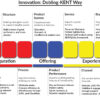
“An ounce of prevention is worth a pound of cure.” This ageless principle of Benjamin Franklin is as true for hospitals and medical colleges as it is for patients. Yesterday as much as today, in a competitive healthcare setting, hoping to wait and then measure financial or operating losses is no safer than putting off a detection of metastasising cancer. Quarterly revenue audits, costing of services lines, and utilization measurements should be no after-death rescue operations but part of an institution’s DNA code.
Why Measurement Matters in Healthcare
Healthcare enterprises exist in an unusually complicated milieu: a service entity, a business entity, and an ethical responsibility all at once. Expenses are on the upswing, reimbursements are decreasing, and patients expect quality combined with affordability. This dilemma renders financial prudence unavoidable.
National Health Policy of India (2017) made efficiency and account-ability of healthcare delivery its core. Along a similar tone, American Hospital Association recommends “proactive financial stewardship” to achieve long-term sustainability. Unless regular audits and utilization parameters are done, hospitals will face stealthy leakage of finances, deteriorating services, and finally loss of reputation.
Tools of Central Vigilance
1. Quarterly Revenue Audits
Quarterly audits spot revenue leakage, unbilled services, and incorrect pricing. A mid-sized Bengaluru-based private hospital decreased revenue loss by 8% when it established quarterly audits that revealed billing errors in diagnostic services.
2. Service Line Costing
Every subspecialty—ENT, cardiology, oncology, or orthopedics—comes with its own cost profile. Service line costing allows an institution to discover which departments are profit generators and which are a cost sink. As Harvard’s Michael Porter explains: “Without a clear understanding of costs, true value in healthcare cannot be measured.”
3. Utilization Metrics
Indicators such as bed occupancy, turnover of operating theaters, or utilization of CT scanners are measurements of efficiency. Indian district hospitals average occupancy rates of as low as 30%, yet multispecialty hospitals in cities suffer from bottlenecks of above 90%. Both situations prove inefficiency.
International and Indian Perspectives
• International Example: Within the UK’s National Health Service (NHS), quarterly observation and “cost improvement plans” are routine. Hospitals that do not achieve efficiency goals face budgetary sanctions. This emphasis on front-end measurement, even if sometimes lambasted as bureaucratized, has maintained into existence one of the largest of the globe’s public health systems.
• Indian Case: Private medical colleges in Karnataka are experiencing growing competition from hospital chains that are corporate. Those that implement structured costing and utilization review have been able to preserve autonomy, whereas those that depend on ad-hoc financial review have either reduced in size or formed mergers.
Dr. Prathap C. Reddy, Founder of Apollo Hospitals, answers this succinctly: “Healthcare cannot fly blind. Measuring cost and outcome is not a luxury—but it is a sustenance of sustained care.”
Benefits of Incorporating Measurement into DNA Construction
1. Early Risk Detection
Regular audits prevent revenue leakage, business fraud, or underperforming assets from ballooning into disasters.
2. Strategic Decision-Making
Service line costing allows leadership to invest in high-impact specialties while closing or rethinking loss-making ones.
3. Improved Efficiency and Patient Satisfaction
Utilization monitoring helps to minimize wait time, optimal occupancy of operation rooms, and improved patient flow.
4. Enhanced Investor and Donor Confidence
For those that are solely dependent on charitable funding or venture capital, clear financial parameters build credibility.
Disadvantages and Problems
1. Implementation Cost
Complex financial systems and qualified audit teams cost money to implement up front, something small hospitals might oppose.
2. Cultural Resistance
Physicians and workers might interpret audits as intrusiveness or micromanaging instead of improvement instruments. This is especially difficult to implement in teaching medical colleges where custom frequently trumps innovation.
3. Risk of Over-Bureaucratization
Too much emphasis on numbers can dilute humanistic aspects of healthcare. As Atul Gawande cautioned us in The Checklist Manifesto: “What gets measured gets managed, but what gets measured and managed poorly can still fail.”
Case Examples
• India: Apollo Hospitals
It unveiled new-age cost models of its service lines in its network and consequently optimised pricing of high-end cardiac cases. This anticipatory measurement fortified its stance against ascendant competition.
• Global: Mayo Clinic, USA
Mayo Clinic combines clinical results with financial measures. Their approach illustrates how it is impossible to measure cost without also measuring risk of quality misleading results.
Advisory Recommendations
1. Embed Metrics in Governance
Committees and boards of trustees should require quarterly utilization and revenue review as standing agenda items.
2. Invest in Digital Dashboards
Implement hospital information systems that give real-time utilization and costing information. Cloud-based systems, now increasingly cost-effective in India, bring financial analytics within reach of all.
3. Train Clinicians in Financial Literacy
Physicians are frequently sheltered from cost structures. Brief modules on healthcare economics, which are now standard in U.S. residencies, must be incorporated into Indian medical colleges.
4. Balance Data with Compass
Metrics should be viewed as instruments to facilitate patient care rather than to supersede it. Patient input must come along with financial analyses so that efficiency doesn’t supersede empathy.
Quotable Insights
• “Quality improvement starts with measurement. We have to measure to understand and if we cannot understand it then we cannot improve it.” — Donald M. Berwick, former Administrator of U.S. Centers for Medicare & Medicaid Services.
• “Heathcare: Efficiency and compassion are not enemies-they’re teammates. Measurement makes sure they both make it.”— Atul Gawande, Doctor and Author.
• “You can’t build a reputation by standing on shaky cornerstone.” – Hilla Mitchell Sinai.
Final thoughts
Healthcare is an noble cause as well as a complicated business. Losses of financial, operational, or reputational types are hard to regain once realized. Preventive audits, cost accounting of services lines, and utilization measurement turn healthcare facilities from reactive fire-fighters into anticipatory keepers of sustainability.
India, as a special combination of corporate hospitals, charitable trusts, and teaching institutions, stands to benefit a lot from putting measurement into its DNA. Elsewhere in the world, lessons from NHS, Mayo Clinic, and Narayana Health make the same point: don’t wait to lose to measure losses. Because in healthcare, the true cost of delay is paid not only in Balance Sheets, but in human lives.
Dr. Prahlada N.B
MBBS (JJMMC), MS (PGIMER, Chandigarh).
MBA in Healthcare & Hospital Management (BITS, Pilani),
Postgraduate Certificate in Technology Leadership and Innovation (MIT, USA)
Executive Programme in Strategic Management (IIM, Lucknow)
Senior Management Programme in Healthcare Management (IIM, Kozhikode)
Advanced Certificate in AI for Digital Health and Imaging Program (IISc, Bengaluru).
Senior Professor and former Head,
Department of ENT-Head & Neck Surgery, Skull Base Surgery, Cochlear Implant Surgery.
Basaveshwara Medical College & Hospital, Chitradurga, Karnataka, India.
My Vision: I don’t want to be a genius. I want to be a person with a bundle of experience.
My Mission: Help others achieve their life’s objectives in my presence or absence!
My Values: Creating value for others.
Leave a reply
















Dear Dr. Prahlada N.B Sir,
Auditing in healthcare is a must, along with patient care and cure outcome; both should go hand in hand for improving healthcare service, sustainability, and thrivability. Your insights on financial prudence in healthcare are truly enlightening. Regular audits, service line costing, and utilization metrics can help healthcare institutions detect revenue leakage, optimize resource allocation, and enhance patient satisfaction.
I appreciate your emphasis on embedding metrics in governance, investing in digital dashboards, and training clinicians in financial literacy. These strategies can empower healthcare organizations to make informed decisions, improve efficiency, and maintain a balance between financial prudence and compassionate care.
Your vision for healthcare is inspiring, and your work at Karnataka ENT Hospital & Research Center is a testament to your dedication to delivering high-quality patient care. Thank you for sharing your expertise and insights with the community.
Reply